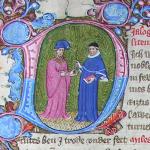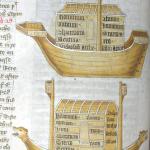TREVISA
Vellum, 15.625 x 12, ff. 280, double columns of 44 lines. Late 14th cent. (after 1387), very well written and with good ornaments.
On flyleaf:
Elegantissimum hunc librum manuscriptum Bibliothecae Coll. S. Joh. Evang. donavit Mr (blank) Baile
de Newington in agro Middlesexiae A.D. 1674.
Collation : 1 flyleaf, a8 – z8 A8 – M8, 1 flyleaf.
Contents :
1. Dialogus inter clericum et militem translated by Trevisa from
the Latin of Ockham . . . . . f. 1
Ich wondre sire noble kny{gh}t {th}at in fewe dayes.
A fine border of English ornament, gold, blue and pink. Initial
D. green ground with gold flourishing. On L. the knight in
pink gown, gold chain and loose blue cap; on R. the clerk in
blue gown with tippet, lined with white fur, black skull-cap,
holding book.
ends f. 5: and nou{gh}t man for {th}e holy day.
Expl. Dialogus inter clericum et militem.
2. Inc. sermo domini Archiepiscopi Armachani (translated by
Trevisa) . . . . . . 5
Deme{th} nou{gh}t bi {th}e face but ri{gh}tful dome {y}e deme. Joh. 8o co.
holy fader in {th}e byginnynge of my sermon.
There are some marginalia in a hand of cent. xv, also in English,
traversing the preacher’s statements.
Ends f. 18b : but ri{gh}tful dome {y}e deme. Qui cum patre, etc.
3. Table in Latin to the Polychronicon . . . . 19
Abraham – Zorobabel. (Will. Rufus added.)
Table in English to the same . . . . 26b
Appolyne delphicus his temple
-Wynchelse i brent.
The Polychronicon of Ranulph Higden in the English version
of Trevisa . . . . . . 34
After solempne and wise writeres of arte
Fine decorative border as on f. 1.
Lib. II, p. 76.
On f. 80b two drawings of the ark, very carefully done.
Lib. III, 105; IV, 146b; V, 176b; VI, 212; VII, 239b.
Ending 280a: to conferme {th}e pees and couenantes in ey{th}er side.
God be {th}onked of al his nedes {th}is translacioun is I ended in
a {th}orsday {th}e ey{gh}te{th}e day of Aueryl {th}e {y}ere of oure lord a
{th}owsand {th}re hondred foure score and seuene {th}e ten{th}e {y}ere
of kyng Richard {th}e secounde after {th}e conquest of Engelond
{th}e {y}ere of my lordes age sire Thomas of Berkeley {th}at made
me make {th}is translacioun fyue anf thrytty. Deo gracias.
See the Rolls edition of the Polychronicon I iv, and facsimile of
a page.
S. L. Fristedt, 'The Wycliffe Bible. Part III. Relationships of Trevisa and the Spanish Medieval bibles', Stockholm Studies in English 28 (1973).
Ronald Waldron, 'The manuscripts of Trevisa's translation of their Polychronicon towards a new edition', Modern Language Quarterly 51:3 (1990), 281-317.
Ronald Waldron, 'Dialect aspects of manuscripts of Trevisa's translation of the Polychronicon', Regionalism in late Medieval Manuscripts and Texts, ed. D. S. Brewer (Cambridge, 1991), pp. 67-87.
A. I. Doyle & M. B. Parkes, 'The production of copies of the Canterbury Tales and the Confessio Amantis in the early fifteenth century'. In M.B. Parkes and A.G. Watson (eds.), Medieval scribes, manuscripts & libraries: essays presented to N.R. Ker (London, 1978) p.206.
For Part 1 see: A. J. Perry, Early English Texts Society 167 (1925).
N. N. Erickson, 'A dispute between a priest and a knight', American Philosophical Society Proceedings 3:5 (1967), 288-309.
A. J. Perry (ed.), Dialogus inter Militem et Clericum By John Trevisa (London, 1925).
For Part 3 see T. J. Renna, 'Kingship in the Disputatio inter clericum et militem', Traditio 48 (1973), 675-93.
S. Drimmer, 'Failure before print (the case of Stephen Scrope)', Viator 46, No.3 (2015), 343-72.

